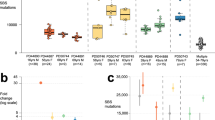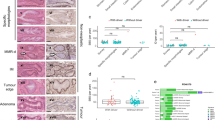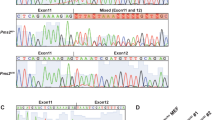Abstract
Cancer predisposition in hereditary non-polyposis colon cancer (HNPCC) is caused by defects in DNA mismatch repair1 (MMR). Mismatch recognition is attributed to two heterodimeric protein complexes: MutSα (refs 2, 3, 4, 5), a dimer of MutS homologues MSH2 and MSH6; and MutSβ (refs 2,7), a dimer of MSH2 and MSH3. These complexes have specific and redundant mismatch recognition capacity8,9,10. Whereas MSH2 deficiency ablates the activity of both dimers, causing strong cancer predisposition in mice11,12,13 and men14,15,16, loss of MSH3 or MSH6 (also known as GTBP) function causes a partial MMR defect. This may explain the rarity of MSH6 and absence of MSH3 germline mutations in HNPCC families17,18. To test this, we have inactivated the mouse genes Msh3 (formerly Rep3 ) and Msh6 (formerly Gtmbp). Msh6-deficient mice were prone to cancer; most animals developed lymphomas or epithelial tumours originating from the skin and uterus but only rarely from the intestine. Msh3 deficiency did not cause cancer predisposition, but in an Msh6 -deficient background, loss of Msh3 accelerated intestinal tumorigenesis. Lymphomagenesis was not affected. Furthermore, mismatch-directed anti-recombination and sensitivity to methylating agents required Msh2 and Msh6, but not Msh3. Thus, loss of MMR functions specific to Msh2/Msh6 is sufficient for lymphoma development in mice, whereas predisposition to intestinal cancer requires loss of function of both Msh2/Msh6 and Msh2/Msh3.
This is a preview of subscription content, access via your institution
Access options
Subscribe to this journal
Receive 12 print issues and online access
$209.00 per year
only $17.42 per issue
Buy this article
- Purchase on Springer Link
- Instant access to full article PDF
Prices may be subject to local taxes which are calculated during checkout




Similar content being viewed by others
References
Kolodner, R. Biochemistry and genetics of eukaryotic mismatch repair. Genes Dev. 10, 1433–1442 ( 1996).
Marsischky, G.T., Filosi, N., Kane, M.F. & Kolodner, R. Redundancy of Saccharomyces cerevisiae MSH3 and MSH6 in MSH2-dependent mismatch repair. Genes Dev. 10, 407– 420 (1996).
Drummond, J.T., Li, G.-M., Longley, M.J. & Modrich, P. Isolation of an hMSH2-p160 heterodimer that restores DNA mismatch repair to tumor cells. Science 268, 1909–1912 ( 1995).
Palombo, F. et al. GTBP, a 160-kilodalton protein essential for mismatch-binding activity in human cells. Science 268, 1912 –1914 (1995).
Iaccarino, I. et al. MSH6, a Saccharomyces cerevisiae protein that binds to mismatches as a heterodimer with MSH2. Curr. Biol. 6, 484–486 (1996).
Drummond, J.T., Genschel, J., Wolf, E. & Modrich, P. DHFR/ MSH3 amplification in metotrexate-resistant cells alters the hMutSα/hMutSβ ratio and reduces the efficiency of base-base mismatch repair. Proc. Natl Acad. Sci. USA 94, 10144– 10149 (1997).
Marra, G. et al. Mismatch repair deficiency associated with overexpression of the MSH3 gene. Proc. Natl Acad. Sci. USA 95, 8568–8573 (1998).
Umar, A. et al. Functional overlap in mismatch repair by human MSH3 and MSH6. Genetics 148, 1637– 1646 (1998).
Genschel, J., Littman, S.J., Drummond, J.T. & Modrich, P. Isolation of MutSβ from human cells and comparison of the mismatch repair specificities of MutSβ and MutSα. J. Biol. Chem. 273, 19895–19901 (1998).
Risinger, J.I. et al. Mutation of MSH3 in endometrial cancer and evidence for its functional role in hetroduplex repair. Nature Genet. 14, 102–105 (1996).
De Wind, N., Dekker, M., Berns, A., Radman, M. & te Riele, H. Inactivation of the mouse Msh2 gene results in mismatch repair deficiency, methylation tolerance, hyperrecombination, and predisposition to cancer. Cell 82, 321– 330 (1995).
Reitmair, A.H. et al. Spontaneous intestinal carcinomas and skin neoplasms in Msh2-deficient mice. Cancer Res. 56, 3842–3849 (1996).
De Wind, N., Dekker, M., Van Rossum, A., Van der Valk, M. & te Riele, H. Mouse models for hereditary nonpolyposis colorectal cancer. Cancer Res. 58, 248– 255 (1998).
Fishel, R. et al. The human mutator homolog MSH2 and its association with hereditary non-polyposis colon cancer. Cell 75 , 1027–1038 (1993).
Leach, F.S. et al. Mutations of a mutS homolog in hereditary nonpolyposis colorectal cancer. Cell 75, 1215– 1225 (1993).
Parsons, R. et al. Hypermutability and mismatch repair deficiency in RER+ tumor cells. Cell 75, 1227– 1236 (1993).
Akiyama, Y. et al. Germ-line mutation of the hMSH6/GTBP gene in an atypical hereditary nonpolyposis colorectal cancer kindred. Cancer Res. 57, 3920–3923 (1997).
Miyaki, M. et al. Germline mutation of MSH6 as the cause of hereditary nonpolyposis colorectal cancer. Nature Genet. 17, 271–272 (1997).
te Riele, H., Robanus Maandag, E. & Berns, A. Highly efficient gene targeting in embryonic stem cells through homologous recombination with isogenic DNA constructs. Proc. Natl Acad. Sci. USA 89, 5128– 5132 (1992).
Rayssiguier, C., Thaler, D.S. & Radman, M. The barrier to recombination between Escherichia coli and Salmonella typhimurium is disrupted in mismatch-repair mutants. Nature 342, 396– 401 (1989).
Selva, E.M., New, L., Crouse, G.F. & Lahue, R.S. Mismatch correction acts as a barrier to homologous recombination in Saccharomyces cerevisiae . Genetics 139, 1175– 1188 (1995).
Umar, A. et al. Correction of hypermutability, N-methyl-N'-nitro- N-nitrosoguanidine resistance, and defective DNA mismatch repair by introducing chromosome 2 into human tumor cells with mutations in MSH2 and MSH6. Cancer Res. 57, 3949– 3955 (1997).
Malkhosyan, S., McCarty, A., Sawai, H. & Perucho, M. Differences in the spectrum of spontaneous mutations in the hprt gene between tumor cells of the microsatellite mutator phenotype. Mutat. Res. 316, 249–259 (1996).
Ohzeki, S., Tachibana, A., Tatsumi, K. & Kato, T. Spectra of spontaneous mutations at the hprt locus in colorectal carcinoma cell lines defective in mismatch repair. Carcinogenesis 18, 1127–1133 (1997).
Edelmann, W. et al. Mutation in the mismatch repair gene Msh6 causes cancer susceptibility. Cell 91, 467– 477 (1997).
Stephenson, C. & Karran, P. Selective binding to DNA base pair mismatches by proteins from human cells. J. Biol. Chem. 264, 21177–21182 ( 1989).
Dolan, M.E., Moschel, R. & Pegg, A.E. Depletion of mammalian O6-alkylguanine-DNA alkyltransferase activity by O6-benzylguanine provides a means to evaluate the role of this protein in protection against carcinogenic and therapeutic alkylating agents. Proc. Natl Acad. Sci. USA 87, 5368–5372 (1990).
Schilling, L.J. & Farnham, P.J. Transcriptional regulation of the dihydrofolate reductase/rep-3 locus. Crit. Rev. Eukaryot. Gene Expr. 4, 19– 53 (1994).
Acknowledgements
We thank K. van Veen and R. Bobeldijk for blastocyst injections; F. van der Ahé, N. Bosnie, L. Rijswijk and A. Zwerver for animal care; J. Bulthuis, C. de Goeij and D. Hoogervorst for the preparation of histological material; J.-H. Dannenberg for performing western-blot analysis; G. Crouse for providing Msh3 antibodies; A. Moschel for providing O 6 -benzylguanine; J. Jiricny for support; and C. Brouwers, J.-H. Dannenberg and S. de Vries for their comments on the manuscript. This work was supported by grant NKI 95-958 from the Dutch Cancer Society to H.t.R.
Author information
Authors and Affiliations
Corresponding author
Rights and permissions
About this article
Cite this article
Wind, N., Dekker, M., Claij, N. et al. HNPCC-like cancer predisposition in mice through simultaneous loss of Msh3 and Msh6 mismatch-repair protein functions. Nat Genet 23, 359–362 (1999). https://doi.org/10.1038/15544
Received:
Accepted:
Issue Date:
DOI: https://doi.org/10.1038/15544
This article is cited by
-
Dose-dependent reduction of somatic expansions but not Htt aggregates by di-valent siRNA-mediated silencing of MSH3 in HdhQ111 mice
Scientific Reports (2024)
-
Truncation of the MSH2 C-terminal 60 amino acids disrupts effective DNA mismatch repair and is causative for Lynch syndrome
Familial Cancer (2017)
-
Loss of MSH2 and MSH6 due to heterozygous germline defects in MSH3 and MSH6
Familial Cancer (2017)
-
Lower prevalence of Lynch syndrome in colorectal cancer patients in a Japanese hospital-based population
Surgery Today (2016)
-
Milestones of Lynch syndrome: 1895–2015
Nature Reviews Cancer (2015)



